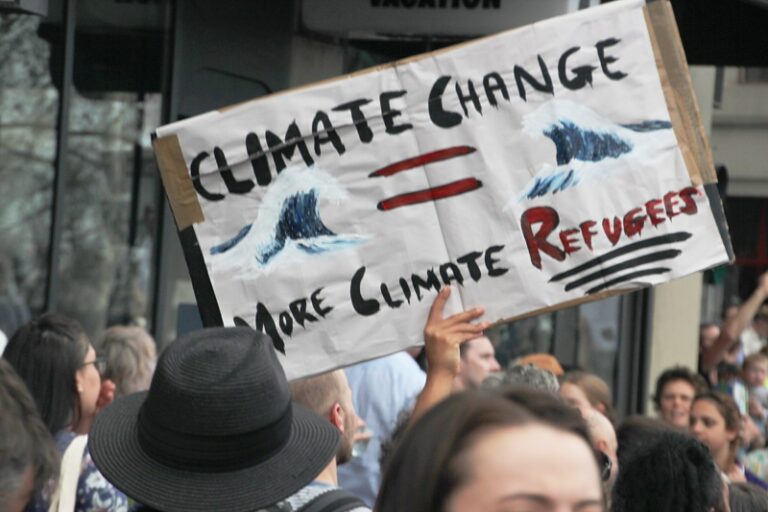Climate Change and the Legal Void: Decoding the Lack of Protections for International “Climate Refugees”
By: Karan Manohar
Climate change, although not a new phenomenon, continues its widespread emergence and pervasive attack on marginalized communities and is projected to displace approximately 1.2 billion people by 2050.[1] Since 2008, the Internal Displacement Monitoring Centre estimates that over 376 million people have been displaced by climate related disasters and events such as floods, windstorms, earthquakes or droughts. [2]
Understanding the link between climate change and displacement
In 2022, the US experienced 18 “billion-dollar weather disasters” with the peak incident being hurricane Ian, which ended up being the 3rd costliest weather disaster ever recorded.[3] Additionally, in 2023, record breaking temperatures, storms, and floods have particularly affected coastal populations and low-lying areas in Libya, the Mediterranean region, Pakistan and in Africa.[4]
This serves as a stark reminder of the potent and costly consequences that climate change can have on displacement on the global scale and within the US.[5] Climate-related disasters significantly affect the quality of life for vulnerable populations within these countries by heightening the risk of food scarcity, increasing the risk of water insecurity, and desertification.[6] These conditions make it more necessary for individuals to migrate to improve their quality of life.[7]
There is a misconception that climate change’s impact is only meant to be temporary, which mistakenly presumes that vulnerable populations and communities who have been displaced will be able to return to their homes.[8] However, contrary to popular belief, the effects of climate change have made living conditions uninhabitable for these populations and communities, thereby making it harder for displaced individuals to return.[9] The IEP’s 2022 Ecological Threat Report demonstrated that several vulnerable countries are woefully unprepared to deal with the projected climate related disasters in 2050.[10] Specifically, the IEP report found that 1 billion people currently live in countries lacking sufficient resources and infrastructure needed to address the heightened food insecurity and water risks stemming from the projected escalation of climate disasters and ecological shocks by 2050.[11] The effects of these ecological events are projected to disproportionately increase food insecurity and natural disasters in North Africa, the Middle East and South Asia.[12]
Furthermore, there is also a direct correlation between countries experiencing high rates of climate disasters and those dealing with perceived conflict and violence.[13] This correlation is in part due to how climate disasters can worsen local conflicts and increase regional tensions.[14] For example, in 2020, over 1 million Afghan citizens were displaced due to ecological disasters, and by 2022, Afghans became the second largest group of asylum seekers within the EU.[15]Additionally, a drought in Somalia forced people from rural areas to relocate to urban areas, and they were met with increased attacks by armed militant groups and increased hostility amongst landlords.[16] This demonstrates how efforts at internal relocation can often be futile at providing adequate protection for those displaced by climate disasters.[17]
The Legal Shortcomings in Recognizing and Protecting Climate Refugees
Dealing with the effects of climate related disasters has become a growing cause of concern amongst the international community.[18] Although not formally recognized, the concept of a “climate refugee” has begun to emerge in order to better situate those individuals displaced by climate-related factors and provide them with refugee status.[19] However, while countries try to prioritize climate change through their own long-term proposals and initiatives, their response remains wholly inadequate in the interim, in part due to the lack of a binding international commitment to recognize climate refugees as a distinct and protected group.[20] This becomes problematic because the lack of a cognizable status for climate refugees puts them in a “legal limbo” and threatens “their need for humanitarian protection.”[21]
Moreover, because climate refugees fall outside the traditional scope of what constitutes a refugee, it becomes increasingly harder for them to get protected by international law.[22] The only binding international laws currently relevant to refugees are the 1951 Convention Relating to the Status of Refugees and the 1967 Protocol Relating to the Status of Refugees.[23] However, these treaties fall short of providing protections for climate refugees, and just broadly define refugees’ rights and nation states’ responsibility to protect those rights.[24] The 1951 Convention is particularly inadequate in providing protections for climate refugees as it creates further ambiguity by failing to provide a clear framework for states to follow to “determine who qualifies as a refugee and how to protect those who do.” [25] This ambiguity makes it harder for countries to reach international consensus on who should qualify as a “climate refugee.”[26]
Despite the consistent and pervasive challenges that climate refugees face, they “pose a number of unique challenges for international policymakers compared to those displaced by persecution, the traditional driver recognized by the 1951 UN Refugee Convention.”[27] This is partly because climate change not only exacerbates displacement through sudden-onset disasters, such as floods, but also through slow-onset environmental changes, like rising sea levels or desertification.[28] These gradual shifts complicate the connection between climate refugees and refugee status, as the displacement may not appear immediate or linked to a singular, identifiable event.[29] Consequently, this makes it harder for individuals affected by the slow onset of environmental changes to obtain refugee status and to be sufficiently protected.[30] The gradual onset of environmental changes can still produce immediate consequences as evidenced by how “the almost total disappearance of Lake Chad because of desertification” has fueled terrorism and led to the forced displacement of over four million people into camps.”[31]
Recent court decisions also have not been promising amidst the increased need for recognition and protection for climate refugees.[32] For example, on July 1, 2024, the U.S Court of Appeals for the First Circuit held in Cruz Galicia v. Garland that climate refugees do not constitute a particular social group.[33] This decision was significant because it marked the first instance in which a U.S. Court of Appeals considered and issued a decision on an asylum claim centered around climate change.[34]
Next Steps and Proposed Solutions
Despite the numerous obstacles hindering efforts to recognize and establish frameworks for climate refugees, several potential solutions remain worth exploring.[35] First, within existing asylum law, it would be imperative to expand and include climate change as one of the factors for seeking asylum.[36] On one hand, this expansion would allow for the devastating consequences of natural disasters to be fully recognized as potentially relating to a “well-founded fear of future persecution.”[37] On the other hand, it could strengthen an individual’s asylum claim by demonstrating how climate change intersects with and informs other recognized grounds for asylum, such as political opinion.[38]
Second, there could be modifications within U.S. domestic law that could be beneficial for providing solutions for climate refugees.[39] For example, the U.S. could legitimize a previously explored path the Biden administration took by offering temporary status to those affected by climate displacement, especially if they can prove a credible threat to their life or health due to climate change.[40] These measures would help to formalize the protection of climate-displaced individuals within national asylum systems.[41]
Third, it may be worth exploring the creation of a framework centered on international cooperation to incentivize collaboration, particularly in vulnerable regions by working to strengthen existing humanitarian protection programs for climate refugees.[42] Advocacy groups have certainly made efforts to promote accountability and justice for populations affected by climate displacement.[43] These efforts have led to notable developments, such as the 2017 advisory opinion issued by the Inter-American Court of Human Rights (IACtHR), which recognized the right to a healthy environment as an autonomous human right.[44] While such advisory opinions represent promising steps in the right direction, they are not legally binding.[45] Therefore, achieving international legitimacy through binding commitments is crucial.[46] Establishing binding commitments through international cooperation would solidify state responsibility and highlight the importance of creating enforceable obligations for international actors to address the challenges faced by climate refugees. [47]
________________________________________
[1] Caitlan M. Sussman, A Global Migration Framework Under Water: How Can the International Community Protect Climate Refugees?, CJIL 2.1 (April 2023), at 41 ,https://cjil.uchicago.edu/sites/default/files/2023-04/2ChiJIntlLOnline41%20%28C.%20Sussman%29.pdf.
[2] Joanna Apap & Sami James Harju, The Concept of ‘Climate Refugee’, EPRS BRI PE 698.753 (Oct. 2023), at 2, https://www.europarl.europa.eu/RegData/etudes/BRIE/2021/698753/EPRS_BRI(2021)698753_EN.pdf.
[3] Id.
[4] Id.
[5] Id.
[6] Id. at 2.
[7] Id.
[8] Id. at 5.
[9] Id.
[10] Id. at 7.
[11] Id.
[12] Id.
[13] Id.
[14] Id.
[15] Id.
[16] Id.
[17] Id.
[18] Id. at 2.
[19] Id.
[20] Id.
[21] Id. at 1.
[22] Sussman, supra note 1, at 50.
[23] Id. at 49.
[24] Id.
[25] Id.
[26] Tim McDonnell, The Refugees the World Barely Pays Attention To, NPR (June 20, 2018), https://perma.cc/7TTP-BNBX.
[27] Id.
[28] Id.
[29] Id.
[30] Id.
[31] Id.
[32] Jose Miranda, Think Immigration: First Circuit Decision on “Climate Refugees” Must Not Discourage Advocates’ Efforts to Help, AILA (August 20, 2024), https://www.aila.org/library/think-immigration-first-circuit-decision-on-climate-refugees-must-not-discourage-advocates-efforts-to-help.
[33] Id.
[34] Id.
[35] Sussman, supra note 1, at 52.
[36] Id. at 62.
[37] Id.
[38] Miranda, supra note 32.
[39] Sussman, supra note 1, at 52.
[40] Id. at 53.
[41] Id.
[42] Id. at 54.
[43] Maria Alejandra Serra & Chris Greenberg, Inside a climate justice case at the Inter-American Court of Human Rights, Greenpeace (July 3, 2024),
[44] Id.
[45] Id.
[46] Sussman, supra note 1, at 54.
[47] Id.


